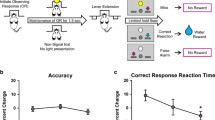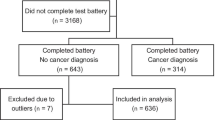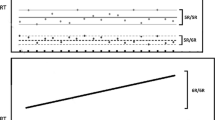Abstract
Cognitive performance is modulated by the neurotransmitter dopamine (DA). Recently, it has been proposed that DA has a strong impact on top-down but not on bottom-up selective visual attention. We tested this assumption by analyzing the influence of two gene variants of the dopaminergic system. Both the catechol O-methyltransferase (COMT) protein and the dopamine transporter (DAT) protein are crucial for the degradation and inactivation of DA. These metabolizing proteins modulate the availability of DA, especially in the prefrontal cortex and basal ganglia. The functional COMT Val158Met polymorphism of the COMT gene represents two coding variants, valine and methionine. In Met allele carriers, the COMT activity is reduced three- to fourfold. A variable number of tandem repeats (VNTR) polymorphism exists in the DAT1 gene, which encodes DAT. The DAT density was reported to be about 50 % higher for the DAT1 10-repeat than the DAT1 9-repeat allele. We assessed attention via two experimental tasks that predominantly measure either top-down processing (the Stroop task) or bottom-up processing (the Posner-Cuing task). Carriers of the Met allele of the COMT Val158Met polymorphism displayed better performance in the Stroop task, but did not outperform the other participants in the Posner-Cuing task. The same result was noted for carriers of the DAT1 10-repeat allele. From these findings, we suggest that normal variations of the dopaminergic system impact more strongly on top-down than on bottom-up attention.




Similar content being viewed by others
References
Alexander, G. E., DeLong, M. R., & Strick, P. L. (1986). Parallel organization of functionally segregated circuits linking basal ganglia and cortex. Annual Review of Neuroscience, 9, 357–381.
Allport, D. A. (1987). Selection for action: Some behavioural and neurophysiological considerations of attention and action. In H. Heuer & D. F. Saunders (Eds.), Perspectives on perception and action (pp. 395–419). Hillsdale, NJ: Erlbaum.
Baayen, R. H., & Milin, P. (2010). Analyzing reaction times. International Journal of Psychological Research, 3(2), 12–28.
Bäckman, L., Ginovart, N., Dixon, R., Wahlin, T. R., Wahlin, A., Halldin, C., & Farde, L. (2000). Age-related cognitive deficits mediated by changes in the striatal DA system. American Journal of Psychiatry, 157, 635–637.
Bertolino, A., Blasi, G., Latorre, V., Rubino, V., Rampino, A., Sinibaldi, L., … Dallapiccola, B. (2006). Additive effects of genetic variation in dopamine regulating genes on working memory cortical activity in human brain. Journal of Neuroscience, 26, 3918–3922.
Bertolino, A., Di Giorgio, A., Blasi, G., Sambataro, F., Caforio, G., Sinibaldi, L., … Dallapiccola, B. (2008). Epistasis between dopamine regulating genes identifies a nonlinear response of the human hippocampus during memory tasks. Biological Psychiatry, 64, 226–234.
Bertolino, A., Fazio, L., Di Giorgio, A., Blasi, G., Romano, R., Taurisano, P., … Sadee, W. (2009). Genetically determined interaction between the dopamine transporter and the D2 receptor on prefrontostriatal activity and volume in humans. Journal of Neuroscience, 29, 1224–1234.
Bilder, R. M., Volavka, J., Lachman, H., & Grace, A. A. (2004). The catechol-o-methyltransferase polymorphism: Relations to the tonic-phasic dopamine hypothesis and neuropsychiatric phenotypes. Neuropsychopharmacology, 29, 1943–1961.
Bouyer, J. J., Dedet, L., Joseph, J. P., & Rougeul, A. (1979). Modification of spontaneous ECoG and behavior in cat by monoamine precursors. Psychopharmacology, 65, 49–54.
Brickenkamp, R., Schmidt-Atzert, D., & Liepmann, D. (2010). Test d2 - Revision. Göttingen: Hogrefe.
Brown, A. B., Biederman, J., Valera, E., Makris, N., Doyle, A., Whitfield-Gabrieli, S., … Seidman, L. (2011). Relationship of DAT1 and adult ADHD to task-positive and task-negative working memory networks. Psychiatry Research, 193, 7–16.
Buschman, T. J., & Miller, E. K. (2007). Top-down versus bottom-up control of attention in the prefrontal and posterior parietal cortices. Science, 315, 1860–1862.
Bush, G., Luu, P., & Posner, M. I. (2000). Cognitive and emotional influences in anterior cingulate cortex. Trends in Cognitive Sciences, 4, 215–222.
Chang, Z., Lichtenstein, P., Asherson, P. J., & Larsson, H. (2013). Developmental twin study of attention problems: High heritabilities throughout development. JAMA Psychiatry, 70, 311–318.
Chao, L. L., & Knight, R. T. (1995). Human prefrontal lesions increase distractibility to irrelevant sensory inputs. Neuroreport, 21, 1605–1610.
Chen, J., Lipska, B. K., Halim, N., Ma, Q. D., Matsumoto, M., Melhem, S., … Weinberger, D. R. (2004). Functional analysis of genetic variation in Catechol-O-Methyltransferase (COMT) - effects on mRNA , protein, and enzyme activity in postmortem human brain. American Journal of Human Genetics, 75, 807–821.
Cools, R., & Robbins, T. W. (2004). Chemistry of the adaptive mind. Philosophical Transactions. Series A, Mathematical, Physical, and Engineering Sciences, 362, 2871–2888.
Corbetta, M., & Shulman, G. L. (2002). Control of goal-directed and stimulus-driven attention in the brain. Nature Neuroscience Review, 3, 201–215.
Cowan, N. (1995). Attention and memory: An integrated framework. New York, NY: Oxford University Press.
Cragg, S. J., & Rice, M. E. (2004). DAncing past the DAT at a DA synapse. Trends in Neuroscience, 27, 270–277.
Davidson, M. C., & Marrocco, R. T. (2000). Local infusion of scopolamine into intraparietal cortex slows covert orienting in rhesus monkeys. Journal of Neurophysiology, 83, 1536–1549.
Divac, I., Rosvold, H. E., & Schwarcbart, M. K. (1967). Behavioural effects of selective ablation of the caudate nucleus. Journal of Comparative and Physiological Psychology, 63, 184–190.
Dosenbach, N. U. F., Fair, D. A., Miezin, F. M., Cohen, A. L., Wenger, K. K., Dosenbach, R. A. T., … Petersen, S. E.(2007). Distinct brain networks for adaptive and stable task control in humans. Proceedings of the National Academy of Sciences, 104, 11073–11078.
Doucette-Stamm, L. A., Blakely, D. J., Tian, J., Mockus, S., & Mao, J. I. (1995). Population genetic study of the human dopamine transporter gene (DAT1). Genetic Epidemiology, 12, 303–308.
Dreher, J. C., Kohn, P., Kolachana, B., Weinberger, D. R., & Berman, K. F. (2009). Variation in dopamine genes influences responsivity of the human reward system. Proceedings of the National Academy of Sciences, 106, 617–622.
Erixon-Lindroth, N., Farde, L., Wahlin, T.-B. R., Sovago, J., Halldin, C., & Bäckman, L. (2005). The role of the striatal DA transporter in cognitive aging. Psychiatry Research, 138, 1–12.
Fossella, J., Sommer, T., Fan, J., Wu, Y., Swanson, J. M., Pfaff, D. W., & Posner, M. I. (2002). Assessing the molecular genetics of attention networks. BMC Neuroscience, 3, 1–11.
Franke, B., Hoogman, M., Arias Vasquez, A., Heister, J. G., Savelkoul, P. J., Naber, M., … Buitelaar, J. K. (2008). Association of the dopamine transporter (SLC6A3/DAT1) gene 9–6 haplotype with adult ADHD. American Journal of Medical Genetics: Part B, 147B, 1576–1579.
Friedman, N. P., & Miyake, A. (2004). The relations among inhibition and interference control functions: A latent-variable analysis. Journal of Experimental Psychology: General, 133, 101–135.
Frings, C., Wentura, D., & Wühr, P. (2012). On the fate of distractor representations. Journal of Experimental Psychology: Human Perception & Performance, 38, 570–575.
Fuke, S., Suo, S., Takahashi, N., Koike, H., Sasagawa, N., & Ishiura, S. (2001). The VNTR polymorphism of the human dopamine transporter (DAT1) gene affects gene expression. The Pharmacogenomics Journal, 1, 152–156.
Fuster, J. (1989). The prefrontal cortex. New York: Raven Press.
Giesen, C., Frings, C., & Rothermund, K. (2012). Investigating the interplay of top-down and bottom-up control of behavior: Differences in the strength of inhibition do not affect distractor-response bindings. Memory & Cognition, 40, 373–387.
Giros, B., Jaber, M., Jones, S. R., Wightman, R. M., & Caron, M. G. (1996). Hyperlocomotion and indifference to cocaine and amphetamine in mice lacking the dopamine transporter. Nature, 379, 606–612.
Goldman-Rakic, P. S., Muly, E. C., III, & Williams, G. V. (2000). D1 receptors in prefrontal cells and circuits. Brain Research Reviews, 31, 295–301.
Grace, A. A. (1995). The tonic/phasic model of dopamine system regulation: Its relevance for understanding how stimulant abuse can alter basal ganglia function. Drug and Alcohol Dependence, 37, 111–129.
Grace, A. A. (2000). The tonic/phasic model of dopamine system regulation and its implications for understanding alcohol and psychostimulant craving. Addiction, 95, S119–S128.
Green, A. E., Munafò, M. R., Deyoung, C. G., Fossella, J. A., Fan, J., & Gray, J. R. (2008). Using genetic data in cognitive neuroscience: From growing pains to genuine insights. Nature Neuroscience Review, 9, 710–720.
Groot, A. S., de Sonneville, L. M. J., Stins, J. F., & Boomsma, D. I. (2004). Familial in influences on sustained attention and inhibition in preschoolers. Journal of Child Psychology and Psychiatry, 45, 306–314.
Heinz, A., Goldman, D., Jones, D.W., Palmour, R., Hommer, D., Gorey, J. G., … Weinberger, D.R. (2000). Genotype influences in vivo dopamine transporter availability in human striatum. Neuropsychopharmacology, 22, 133-139.
Hoffman, J. E., & Nelson, B. (1981). Spatial selectivity in visual search. Perception & Psychophysics, 30, 283–290.
James, W. (1890). The principles of psychology. New York, NY: Henry Holt & Co.
Kang, A. M., Palmatier, M. A., & Kidd, K. K. (1999). Global variation of a 40-bp VNTR in the 3′-untranslated region of the dopamine transporter gene (SLC6A3). Biological Psychiatry, 46, 151–160.
Klein, R. M., & Lawrence, M. A. (2012). On the modes and domains of attention. In M. I. Posner (Ed.), Cognitive neuroscience of attention (pp. 11–29). New York: Guilford Press.
Lachman, H. M., Papoulos, D. F., Saito, T., Yu, Y.-M., Szumlanski, C. L., & Weinshilboum, R. M. (1996). Human catechol-o-methyltransferase pharmacogenetics: Description of a functional polymorphism and its potential application to neuropsychiatric disorders. Pharmacogenetics, 6, 243–250.
Lewis, D. A., Melchitzky, D. S., Sesack, S. R., Whitehead, R. E., Auh, S., & Sampson, A. (2001). Dopamine transporter immunoreactivity in monkey cerebral cortex: Regional, laminar, and ultrastructural localization. Journal of Comparative Neurology, 432, 119–136.
Li, D., Sham, P. C., Owen, M. J., & He, L. (2006). Meta-analysis shows significant association between DA system genes and attention deficit hyperactivity disorder (ADHD). Human Molecular Genetics, 15, 2276–2284.
MacDonald, A. W., Cohen, J. D., Stenger, V. A., & Carter, C. S. (2000). Dissociating the role of dorsolateralprefrontal cortex and anterior cingulated cortex in cognitive control. Science, 288, 1835–1838.
MacLeod, C. M. (1991). Half a century of research on the Stroop Effect - an integrative review. Psychological Bulletin, 109, 163–203.
Matsumoto, M., Weickert, C. S., Akil, M., Lipska, B. K., Hyde, T. M., Herman, M. M., … Kleinman, J. E. (2003a). Catechol-o-methyltransferase mRNA expression in human and rat brain: Evidence for a role in cortical neuronal function. Neuroscience, 116, 127–137.
Matsumoto, M., Weickert, C. S., Beltaifa, S., Kolachana, B., Chen, J., Hyde, T. M., … Kleinman, J. E. (2003b). Catechol-o-methyltransferase (COMT) mRNA expression in the dorsolateral prefrontal cortex of patients with schizophrenia. Neuropsychopharmacology, 28, 1521–1530.
Mattay, V. S., Goldberg, T. E., Fera, F., Hariri, A. R., Tessitore, A., Egan, M. F., … Weinberger, D. R. (2003). Catechol O-methyltransferase val158-met genotype and individual variation in the brain response to amphetamine. Proceedings of the National Acadamy of Sciences, 100, 6186–6191.
Mier, D., Kirsch, P., & Meyer-Lindenberg, A. (2009). Neural substrates of pleiotropic action of genetic variation in COMT: A meta-analysis. Molecular Psychiatry, 15, 918–927.
Mignone, F., Gissi, C., Liuni, S., & Pesole, G. (2002). Untranslated regions of mRNAs. Genome Biology, 3, REVIEWS0004.
Mill, J., Asherson, P., Browes, C., D’Souza, U., & Craig, I. (2002). Expression of the DA transporter gene is regulated by the 3′UTR VNTR: Evidence from brain and lymphocytes using quantitative RT–PCR. American Journal of Medical Genetics, 114, 975–979.
Miller, E. K., & Cohen, J. D. (2001). An integrative theory of prefrontal cortex function. Annual Review of Neuroscience, 24, 167–202.
Mitchell, R. J., Howlett, S., Earl, L., White, N.G., McComb, J., Schanfield, M.S., … Crawford, M. H. (2000). Distribution of the 3′ VNTR polymorphism in the human dopamine transporter gene in world populations. Human Biology, 72, 295-304.
Montaron, M. F., Bouyer, J. J., Rougeul, A., & Buser, P. (1982). Ventral mesencephalic tegmentum (VMT) controls electrocortical beta rhythms and associated attentive behaviour in the cat. Behavioural Brain Research, 6, 129–145.
Neumann, O. (1987). Beyond capacity: A functional view of attention. In H. Heuer & A. F. Saunders (Eds.), Perspectives on perception and action (pp. 361–394). Hillsdale, NJ, England: Lawrence Erlbaum Associates.
Nieoullon, A. (2002). Dopamine and the regulation of cognition and attention. Progress in Neurobiology, 67, 53.83.
Noudoost, B., & Moore, T. (2011). The role of neuromodulators in selective attention. Trends in Cognitive Sciences, 15, 585–591.
Öhman, A., Flykt, A., & Esteves, F. (2001). Emotion drives attention: Detecting the snake in the grass. Journal of Experimental Psychology: General, 130, 466–478.
Pashler, H. E. (1998). The psychology of attention. Cambridge: MIT Press.
Peinemann, A., Schuller, S., Pohl, C., Jahn, T., Weindl, A., & Kassubek, J. (2005). Executive dysfunction in early stages of Huntington’s disease is associated with striatal and insular atrophy: A neuropsychological and voxel-based morphometric study. Journal of the Neurological Sciences, 239, 11–19.
Petersen, S. E., & Posner, M. I. (2012). The attention system of the human brain: 20 years after. Annual Review of Neuroscience, 35, 73–89.
Posner, M. (1980). Orienting of attention. Quarterly Journal of Experimental Psychology, 32, 3–25.
Posner, M. I., & Petersen, S. E. (1990). The attention system of the human brain. Annual Reviews in Neuroscience, 13, 25–42.
Ratcliff, R. (1993). Methods for dealing with reaction time outliers. Psychological Bulletin, 114, 510–532.
Rietveld, M. J. H., Hudziak, J. J., Bartels, M., van Beijsterveldt, C. E. M., & Boomsma, D. I. (2004). Heritability of attention problems in children: Longitudinal results from a study of twins, age 3 to 12. Journal of Child Psychology and Psychiatry, 45, 577–588.
Rösler, M., Retz, W., Retz-Junginger, P., Thome, J., Supprian, T., Nissen, T., … Trott, G. E. (2004). Instrumente zur Diagnostik der Aufmerksamkeitsdefizit-/Hyperaktivitätsstörung (ADHS) im Erwachsenenalter. Nervenarzt, 9, 888–895.
Rueda, M. R., Rothbart, M. K., McCandliss, B. D., Saccomanno, L., & Posner, M. I. (2005). Training, maturation, and genetic influences on the development of executive attention. Proceedings of the National Academy of Sciences, 102, 14931–14936.
Seamans, J. K., & Yang, C. R. (2004). The principal features and mechanisms of dopamine modulation in the prefrontal cortex. Progress in Neurobiology, 74, 1–58.
Sesack, S. R., Hawrylak, V. A., Matus, C., Guido, M. A., & Levey, A. (1998). DA axon varicosities in the prelimbic division of the rat prefrontal cortex exhibit sparse immunoreactivity for the DA transporter. Journal of Neuroscience, 18, 2697–2708.
Sridharan, D., Levitin, D. J., Chafe, C. H., Berger, J., & Menon, V. (2007). Neural dynamics of event segmentation in music: Converging evidence for dissociable ventral and dorsal
Stroop, J. R. (1935). Studies of interference in serial verbal reactions. Journal of Experimental Psychology, 18, 643–662.
Tenhunen, J., Salminen, M., Lundström, K., Kiviluoto, T., Savolainen, R., & Ulmanen, I. (1994). Genomic organization of the human catechol-o-methyltransferase gene and its expression from two distinct promoters. European Journal of Biochemistry, 223, 1049–1059.
Thierry, A.-M., Tassin, J. P., Blanc, G., & Glowinski, J. (1976). Selective activation of the mesocortical DA system by stress. Nature, 263, 242–244.
Tisch, S., Silberstein, P., Limousin-Dowsey, P., & Jahanshahi, M. (2004). The basal ganglia: anatomy, physiology, and pharmacology. Psychiatric Clinics of North America, 27, 757–799.
Tukey, J. W. (1977). Exploratory data analysis. Reading, MA: Addison-Wesley.
Tunbridge, E. M., Harrison, P. J., & Weinberger, D. R. (2006). Catechol-o-methyltransferase, cognition, and psychosis: Val158Met and beyond. Biological Psychiatry, 60, 141–151.
Vandenbergh, D. J., Perslco, A. M., Hawkins, A. L., Griffin, C. A., Li, X., Jabs, E. W., & Uhl, G. R. (1992). Human DA transporter gene (DAT1) maps to chromosome 5p15.3 and displays a VNTR. Genomics, 14, 1104–1106.
VanNess, S. H., Owens, M. J., & Kilts, C. D. (2005). The variable number of tandem repeats element in DAT1 regulates in vitro DA transporter density. BMC Genetics, 6, 1–11.
Volkow, N. D., Wang, G. J., Newcorn, J., Fowler, J. S., Telang, F., Solanto, M.V., … Pradhan, K. (2007). Brain dopamine transporter levels in treatment and drug naïve adults with ADHD. Neuroimage, 34, 1182–1190.
Ward, N. M., & Brown, V. J. (1996). Covert orienting of attention in the rat and the role of striatal dopamine. The Journal of Neuroscience, 16(9), 3082–3088.
Winterer, G., & Weinberger, D. R. (2004). Genes, DA and cortical signal-to-noise ratio in schizophrenia. Trends in Neuroscience, 27, 683–690.
Wühr, P., & Frings, C. (2008). A case for inhibition: Visual attention suppresses the processing of irrelevant objects. Journal of Experimental Psychology: General, 137, 116–130.
Xie, T., Ho, S. L., & Ramsden, D. B. (1999). Characterization and implications of estrogenic down-regulation of human catechol-o-methyltransferase gene transcription. Molecular Pharmacology, 56, 31–38.
Yacubian, J., & Büchel, C. (2009). The genetic basis of individual differences in reward processing and the link to addictive behavior and social cognition. Neuroscience, 164, 55–71.
Yacubian, J., Sommer, T., Schroeder, K., Glascher, J., Kalisch, R., Leuenberger, B., … Büchel, C. (2007). Gene–gene interaction associated with neural reward sensitivity. Proceedings of the National Academy of Sciences, 104, 8125–8130.
Acknowledgments
This study was supported by a research fund from the University of Trier, Trier, Germany. The authors would like to thank Ulrike Winnikes for her technical assistance.
Author information
Authors and Affiliations
Corresponding author
Appendix
Appendix
Rights and permissions
About this article
Cite this article
Schneider, K.K., Schote, A.B., Meyer, J. et al. Genes of the dopaminergic system selectively modulate top-down but not bottom-up attention. Cogn Affect Behav Neurosci 15, 104–116 (2015). https://doi.org/10.3758/s13415-014-0320-9
Published:
Issue Date:
DOI: https://doi.org/10.3758/s13415-014-0320-9




